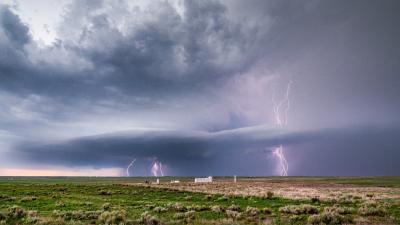Building a Theoretical Dynamical Model for Thunderstorms over the United States
Mesoscale convective systems (MCSs) bring large amounts of rainfall and strong wind gusts to mid-latitude land regions. However, it is challenging to understand and model the underlying mechanisms that initiate and propagate MCSs. Thus, scientists are motivated to develop theoretical models that isolate the basic mechanisms of MCSs. To this end, researchers developed a simple moist potential vorticity (PV) model. This model captures the realistic properties of MCSs and describes the interactions among PV perturbations, air moisture, and soil moisture. Model experiments show that mechanical forcing can induce lower-level updrafts and cooling, providing favorable conditions for initiating MCSs. A positive feedback mechanism among surface winds, evaporation rate, and air moisture intensifies MCSs. In addition, the background surface westerlies and vertical westerly wind shear provide favorable conditions for the eastward propagation of MCSs. This model highlights the crucial role of stratiform heating in shaping the mesoscale circulation response.
Convective storms such as MCSs cause economic losses in the United States of more than 20 billion dollars annually. State-of-the-art climate models still have significant biases when simulating mid-latitude MCSs because of multiple controlling factors and interactions. The moist PV dynamical model describes the dominant mesoscale circulation and moisture exchange between the atmosphere and land during the MCS life cycle over a mid-latitude land region. This model is useful for understanding the fundamental mechanisms of MCS dynamics and improves the modeling of MCSs in more complex models.
A theoretical dynamical model of the MCS dynamics was developed to capture the realistic properties of MCSs and isolate the basic mechanisms for their initiation, intensification, and eastward propagation. Researchers achieved these goals by (1) extending a dry PV model in the literature to a moist version by incorporating the moisture exchange between the free troposphere and soil as well as their interactions with the mesoscale circulation, (2) exploring the mechanical and thermal factors that initiate and intensify MCSs, (3) investigating the effects of the background surface wind and vertical shear on MCS propagation, and (4) studying the role of stratiform heating in determining the MCS dynamics and vertical structure. The model can provide useful guidelines for improving weather and climate model forecasts.

